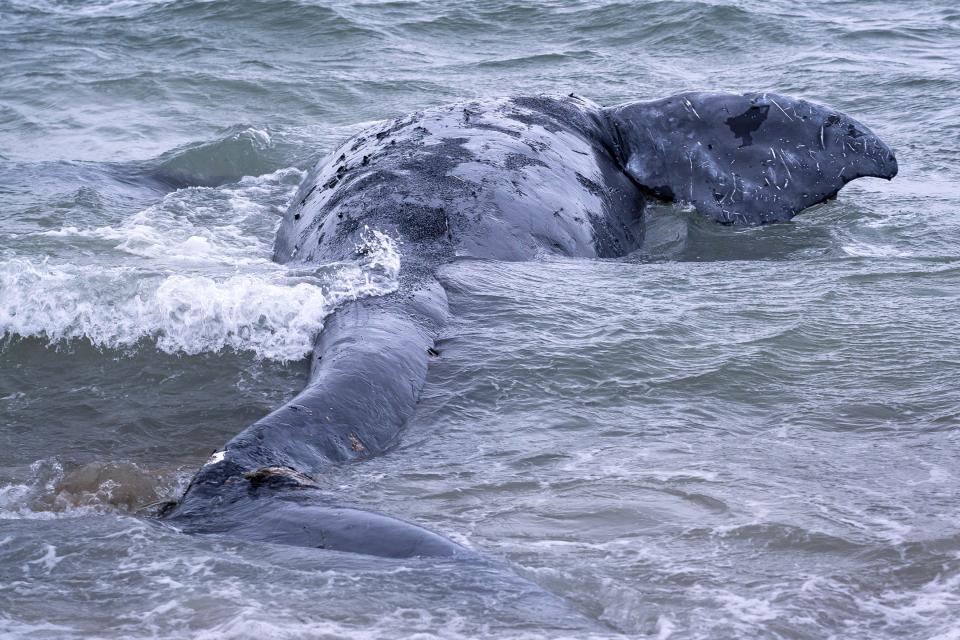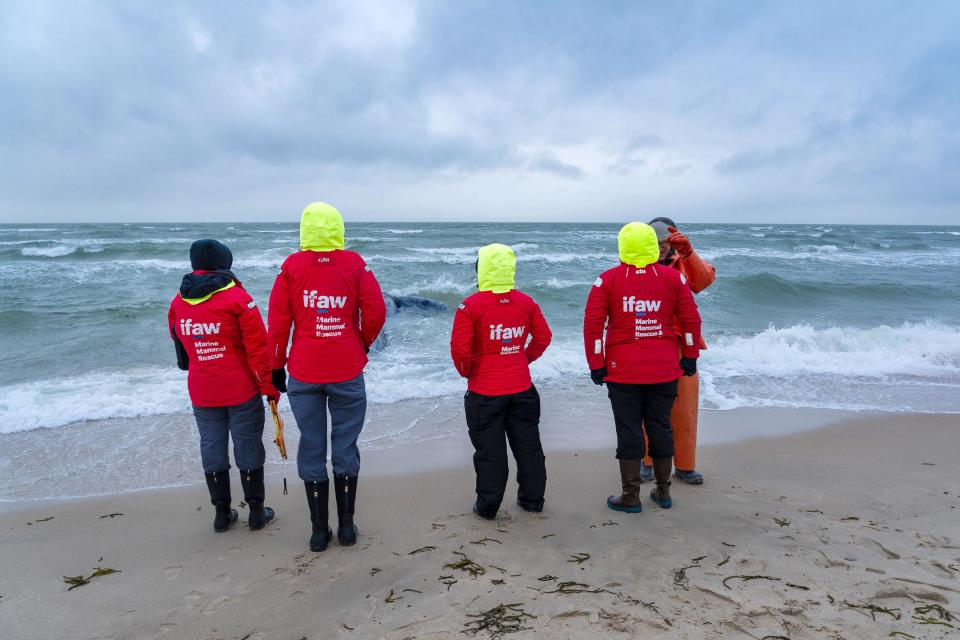Whale autopsy? After dead whale washes up on Martha's Vineyard beach, scientists step in
Discovery of a deceased female North Atlantic right whale near Joseph Sylvia State Beach on Martha's Vineyard has set off a response from marine veterinarians and biologists looking for clues about how the whale died.
A team from the International Fund for Animal Welfare headquartered in Yarmouth Port was deployed to the site on Monday and was at work again Tuesday to determine next steps, reported Brian Sharp, director of Marine Mammal Rescue for the nonprofit.
"It got reported to us and NOAA Fisheries Sunday night just before sunset," Sharp said.
The whale was found just south of the barrier beach that stretches for about two miles between Oak Bluffs and Edgartown with Nantucket Sound on one side and Sengekontacket Pond on the other, he said.

What happens when a deceased whale washes ashore?
Handling whale deaths like this one requires a coordinated effort by multiple responders and involves a checklist of steps.
According to NOAA, those include everything from sending an initial response team to assess the situation, making arrangements to tow the remains out of the water, securing the animal from tides and possible souvenir hunters, sometimes moving the animal to another site for examination, putting together a team to conduct a necropsy, and finally deciding the best means of putting the animal to its final rest.
The process can take a few days, and results from the necropsy may not offer conclusions for a few weeks.
When the beach is too small, whale must be towed to another location
In this case, the IFAW team was able to secure the remains of the female whale with the help of the Wampanoag Tribe of Gay Head (Aquinnah). Sharp said the animal was in the surf, so the team used a rope and an anchor set above the high tide line to keep the remains from washing back out into Nantucket Sound while the team awaited better weather conditions and planned next steps.
Usually, the necropsy would be performed on the beach where remains wash up. But the stretch of shore where this whale was found, Sharp said, is very narrow and offers no space to maneuver the remains or for the scientists to work. So, other plans need to be made.
Thought to be a juvenile because of her size, the whale is about 27 to 30 feet, which Sharp said is a little bit shorter than a school bus. She weighs an estimated 11 tons.
"It requires heavy equipment to move the animal, and we're trying to source an excavator and front-end loaders," he said.
Since they can't get the heavy equipment onto the beach, the team will need to rig up a line to tow the carcass farther ashore, before loading it to transport to another location for the necropsy. Where the remains will be taken had yet to be determined.
"We're working with municipalities and different government officials over there to find a location," he said.

What does a necropsy involve?
Once the whale is to a new spot, a necropsy will be done.
The necropsy — described by NOAA as "the examination of the dead body or carcass of an animal, similar to an autopsy conducted on humans" — will be a more in-depth investigation into the whale's condition at time of death and possible causes of death.
A number of people are needed to undertake whale necropsies. Sharp expects this team will include 22 to 25 people, including members of the IFAW team and local and regional responders.
According to NOAA, necropsy teams take measurements and collect biological samples from many parts of the animal, which typically include skin, blubber, muscle, baleen, and internal organs. They will look for signs of disease or trauma and try to determine the overall health of the animal at the time of death.
The leading causes of death for right whales are entanglements in traditional fishing gear and injuries caused by vessel strikes, though other causes are also possible. Sharp said this whale had some rope wrapped around its peduncle, which is where the tail flukes connect to the body, but that is not enough to determine cause of death.
Early report: Right whale juvenile found dead off Martha's Vineyard. Group says species is 'plunging toward oblivion'
What happens to whale remains after an investigation?
Once the necropsy is done, the team determines the best way to handle the remains. If a body can be left on a beach to decay on its own, it will be. But on beaches frequented by the public, the body is buried.
The responders in this case will need to find a place to bury the whale's remains, whether it be at the location where the necropsy takes place or on a beach other than the one where the whale was found since there is no room there.
Why is this whale's death such a big deal?
Scientists estimate only about 356 — plus or minus seven —of the critically endangered North Atlantic right whales, plus or minus seven, are alive today, and relatively few of them are reproductively able females, according to the latest population study released last fall.
With a population that small, every animal is a devastating loss, and even more significant when it's a female.
"Getting these calls of a dead animal like this on our hotline is like a punch to the gut," Sharp said.
Just as difficult is coming face to face with it as a responder, he said, "but we have a job to do as veterinarians and biologists to figure out what the cause of death was" and provide that information to government agencies so, hopefully, something can be done about preventable deaths.
News of this whale's death is making waves in scientific and conservation communities, made all that much more discouraging coming on the heels of news last week of a newborn calf suffering severe injuries from an apparent boat strike off the coast of South Carolina. If the calf is unable to nurse, it will not survive, though as of Jan. 26 it was reported to be alive.
“This has been a tragic month for North Atlantic right whales," said Philip Hamilton, senior scientist in the Anderson Cabot Center for Ocean Life at the New England Aquarium on Tuesday, citing the calf's injury and the juvenile female's death.
"The time to implement bold protections to protect this critically endangered species from human-caused impacts is now if we are to avoid extinction," he said.
Scientists with the New England Aquarium are working with responding agencies — which also include Woods Hole Oceanographic Institution and the Massachusetts Environmental Police — to provide support in identifying and providing the life history of the deceased whale, according to the aquarium.
Heather McCarron writes about climate change, environment, energy, science and the natural world. Reach her at hmccarron@capecodonline.com, or follow her on X @HMcCarron_CCT
Thanks to our subscribers, who help make this coverage possible. If you are not a subscriber, please consider supporting quality local journalism with a Cape Cod Times subscription. Here are our subscription plans.
This article originally appeared on Cape Cod Times: What happens when a dead whale washes up on a Cape or Islands beach?

